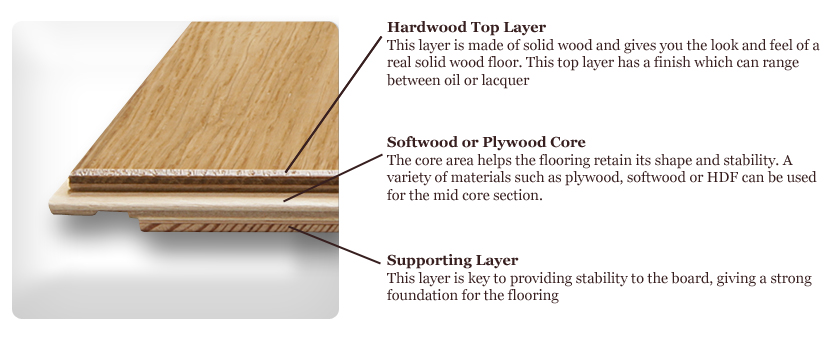ENGINEERED & PREFINISHED FLOORS
Prefinished and engineered flooring was developed quite a while ago, but it really became popular in the 1970’s. The flooring comes directly from the factory with stain and a very durable finish, both already applied. A difference between engineered and prefinished floors is such that prefinished flooring is
made solely of solid wood, while engineered flooring has only a top layer of solid wood, the rest is made of plywood and wood substitutes. Engineered and prefinished flooring is blind nailed or glued to the subfloor. Where it must be face nailed, the nails are set and the holes filled with a colored wax that matches the finish. As it ages, a solid-wood prefinished floor can be sanded and refinished many times, just like a conventional hardwood floor. Engineered floors, having a thinner layer of solid-wood can be also sanded, but only one or two times.
Engineered flooring comprises several layers of wood stuck together under extremely high pressures. This method of construction helps in creating wood flooring, which boasts higher strength and durability compared to a wood floor of solid material.
Construction of Engineered Flooring

Most solid floors have a tendency to shrink as well as expand. This happens because of room humidity changes, changing room temperature, as well as moisture in the sub-floor. The unique construction method of engineered flooring is not prone to these problems.
This flooring comprises three different layers - bottom layer, middle core and top layer. The mid core is made from plywood, softwood or even HDF layers and the top layer is hardwood. Its thickness ranges between 0.7 mm to around 6 mm.
Advantages
Engineered flooring has several advantages, the biggest being easy installation. Using the floating floor method, fast and easy click installation is possible with these products.
Alternatively, tongue and grooves can be stuck together which is an advantage when you are installing your floor on a concrete subfloor. Even floors of 22mm thickness can provide proper structure and they are nailed into the battens or joists.
The top layer has a finish of matt lacquer, satin lacquer, oiled, brushed and lacquered, brushed and oiled, or age distressed. Your choice with these will come down to personal preference. Six coats of this finish can be easily provided.
The layer of hardwood varies in thickness from 0.7 mm to around 6 mm, and the middle core area is designed to help the flooring retain its shape and stability.
A variety of materials such as hardwood, softwood or HDF can be used for the mid core section. There is an additional layer of stabilizing agents provided, of 1 mm thickness. This provides stability and prevents flooring movement because of changes in temperature or humidity.
Engineered Flooring Looks as Good as Solid Wood
Because the top layer of this type of flooring is similar to solid wood floors there are no compromises in terms of style because the finish is the same.
Engineered flooring is designed to resemble hardwood so you will also find the same great selection of species, shades and colors as you would with solid wood.
How Thick is the Veneer of Hardwood?
The hardwood veneer is the topmost layer of engineered flooring. It ranges in thickness between 0.6 mm to around 6 mm.
This particular part of the floor offers high durability, just like any solid wood flooring, and the other layers mean that it is even stronger. The wear layer has a thicknesses of around 4-8 mm located above the groove and tongue.
Is Refinishing Possible?
Most hardwood layers are not refinished; however, this does not mean that it can not be done. The possibility of refinishing depends on the hardwood thickness.
Using high quality techniques, all damaged regions are eliminated professionally. As much as 0.5 mm thickness can be removed with sanding. However, the upper wear layer should never be reduced more than 0.5 mm as you risk damaging your floor.
Below, please find the photo samples of different finishes:

Lapaho |

Windham Maple |

Alden Maple |

Couvertury Maple |

True Teak |

Brazilian Teak |

Brazilian Cherry |

Natural African Walnut |

Natural Hickory |

Iron Wood |

Burma Teak |

Brazilian Walnut |

Tatami Oak |

Elton Maple |

Rococo
|

Brazilian Rosewood |
|
|
|